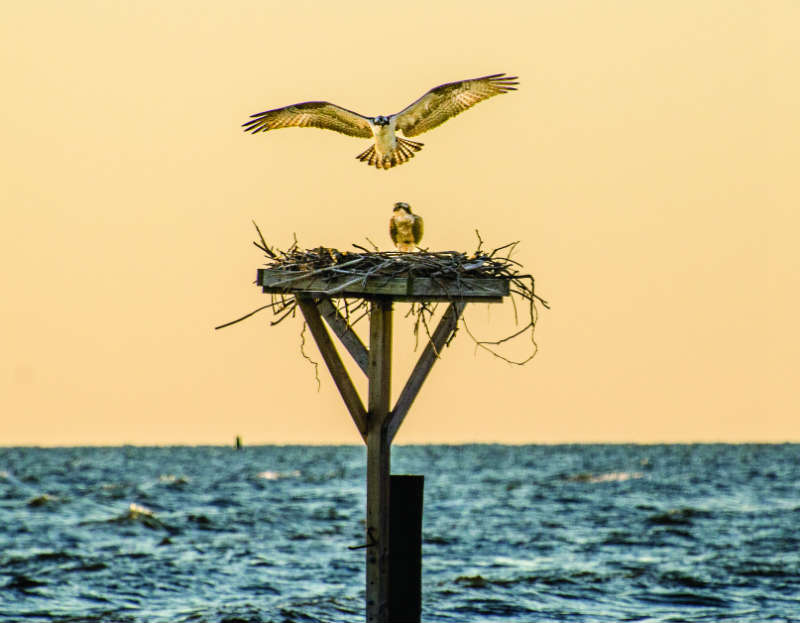Following Osprey from South American to the Chesapeake Bay
A fish hawk wheels out of the gray sky as a rainy wind spits against the shore of the Chesapeake Bay south of Annapolis. The white-headed bird with hooked claws—an osprey—circles above leafless trees and bent reeds before landing on a nest of sticks. Soon a second osprey appears with a fish in its claws. It circles, then lands beside its mate on the platform atop a telephone pole. The two are among the first osprey to return to the Chesapeake Bay this spring after an epic migration of more than 2000 miles from South America. “After a dreadful winter, spring is finally here,” says Don Baugh, vice president for education at the Chesapeake Bay Foundation (CBF). “The osprey are more of a harbinger of spring than Saint Patrick’s Day, more of a harbinger perhaps than the Equinox.”

Suddenly, a great blue heron swoops over the nest. An osprey leaps into the air and attacks the larger bird. The osprey dive-bombs the heron, with the osprey’s claws outstretched as weapons to fight off the intruder. “Whoa!” says Baugh, as he watches the aerial confrontation. “The osprey is basically taking its territory and saying, ‘No!’ Wow! What a wonderful site that was.” Osprey are powerful, globe-trotting birds. To study and better understand the species, CBF recently organized a global osprey tracking project. CBF teamed up with a company called Microwave Telemetry, Inc. that specializes in tracking wildlife, and ornithologist Rob Bierregaard. In April 2013, the team attached tiny, solar-powered backpacks with cell-phone-like devices to two birds nesting in Tangier Sound, in Virginia, and a third in Whitehall Bay, in Anne Arundel County.
Over the last year, the devices have been tracking the birds' flight patterns from the northern to the southern hemispheres and, now, back again. “This is a really great project: a partnership between Microwave Telemetry and CBF to look at the travel habits of birds,” says John Rodenhausen, CBF's director of development for Maryland. “We are able to follow the osprey migrations on a website that shows us how they travel not only during the day, but also in their seasonal migration.”
The birds being monitored are named Nick, Woody, Tango, and Quinn. Students or anyone curious about their adventures can follow the daily progress of their migration by visiting this website: cbf.org/ospreymap. After flying south from the Chesapeake Bay last fall, the osprey named Tango spent much of the winter and early spring hanging out in Venezuela. He fished for several months in Lake Valencia, which—as it turns out—has fertilizer pollution problems and algae blooms very much like the Chesapeake Bay’s.
“The osprey is cosmopolitan. Our problems are cosmopolitan," Baugh says. "If you look at our nutrient pollution here in the Chesapeake, this is a worldwide problem. If you look at the disappearance of our underwater grasses, it is a worldwide problem. I can assure you, osprey know more about pollution in our waterways than we do, because that’s where they are.” One thing that is clearly getting better for osprey around the world is their reproduction, according to Dr. Bryan Watts, director of the Center for Conservation Biology at the College of William and Mary. “The Chesapeake Bay population has been growing exponentially since the early 1970s and is absolutely huge now," Dr. Watts says. "The population bottomed out in the early 1970s at below 1500 pairs. And we are probably in the neighborhood of 6000 to 8000 pairs in the Bay now. Just an absolutely huge population.”
The main reason for the dramatic growth in the osprey population, Watts says, was EPA’s decision in 1972 to ban the insecticide DDT, which weakened the shells of eggs. Osprey, however, still face threats during their long migrations, including oil spills in Venezuela, and occasionally being shot by hunters in Haiti, Cuba, and elsewhere in the Caribbean. So as the osprey fly home to the Chesapeake Bay, and then spend the spring and summer here, watch them on the map at cbf.org/ospreymap. Keep an eye out for our friends, Woody, Tango, Nick, and Quinn. And pray that they keep safe.
~By Tom Pelton (May 2014)




